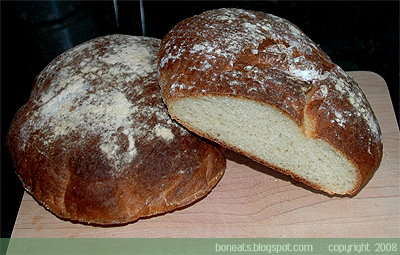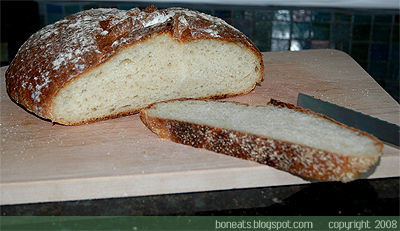Il pane italiano

Sometimes you need a quick, reliable recipe to turn to for a quick fix, and easy bread recipes like French Country Style or this Italian Bread is always my go-to for an easy and fast route towards good, homemade bread. While it is quick and easy, and uses ingredients that are usually readily available in one's pantry (more so with the French Country Style), it does require a bit of planning ahead since both recipes call for a poolish, or a starter, a kind of "cheater's" version to a sourdough starter. The minimum time requirement to allow a starter to ferment is usually 4 hours, but I usually like to stretch it out to up to 16 hours. Therefore, if you're thinking of making bread the next day, it's best to mix together the poolish ingredients the night before and let it do its thing overnight. Remember, the longer you let your poolish ferment, the greater you maximize the flavour of your bread.
What's interesting to this recipe is that it uses dry milk powder, an ingredient I've only used before in fat-enriched breads like the Milk Loaf. The addition of the milk powder also adds another dimension of flavour to the bread, along with the poolish. The resulting loaf is one with an incredibly crispy exterior, a fine crumb and a chewy texture. This is great sliced thickly and slathered with butter, and makes a great sandwich bread.
Italian Bread
Adapted from The Fresh Loaf
Makes 2 medium loaves
Poolish
1/2 cup water, about 100°-115°F
1/2 cup bread flour
1/4 tsp dry active yeast
Dough
All of the preferment
2 1/2 cups bread flour, plus more as needed (up to 1/2 cup more)
1/4 cup nonfat dry milk powder
1/2 tbsp honey or brown sugar
1/2 tbsp salt
1 tsp dry active yeast
1/2 tbsp olive oil
1 cup water, about 100°-115°F
To start the poolish, mix together the flour, water, and yeast in a small bowl and cover with plastic wrap. Leave out at room temperature for at least 4 hours and as long as 16 hours.
To make the dough, dissolve the honey in the water, and then sprinkle the yeast over the water. Set aside for 10 minutes, or until foamy. Mix together the poolish, olive oil, salt, dry milk powder and yeast mixture in a bowl with 1/2 cup of flour. Mix thoroughly with a paddle attachment until creamy, about 1 minute. Mix knead in the rest of the flour a half a cup at a time until the dough starts to come away from the sides of the bowl. Switch to the hook attachment and knead in the remaining flour until you have a slack dough but one that is no longer sticky. Continue kneading until dough is smooth and elastic, about 10 to 15 minutes.
Place the dough in a well-greased bowl and cover with plastic wrap. Allow to rise at room temperature until at least 2 times in size, approximately 1 1/2 to 2 hours. Punch the dough down and let it rise again for half an hour.
Remove the dough from the bowl and divide it in half. Shape the dough into a ball or log, cover with a damp towel, and allow it to relax for another 20 minutes.
Shape the dough into its final shape. Cover again and allow to rise for another hour until doubled in bulk.
Meanwhile, preheat the oven and baking stone, if you are using one, to 475°F. Right before placing the loaves in the oven, score the top and brush or spray them lightly with water. Place them into the oven, immediately reduce the temperature to 425°F and bake for 15 minutes, spraying the loaves with water in 5 minute intervals for the first 15 minutes of baking. Rotate the tray and bake for another 5 to 10 minutes, or until the internal temperature of the loaf reads 200°F and sounds hollow when tapped from underneath. Reove from the oven and allow to cool on a baking rack for at least a half an hour before serving.







0 comments:
Post a Comment